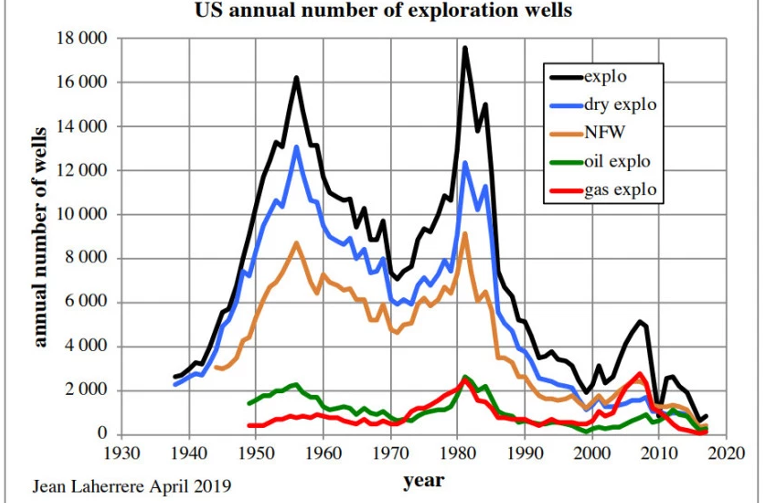It is well known that oil discoveries are in continuous decline worldwide in spite of ever-increasing investments. What is less known, however, is that spending on oil exploration is fast dropping in the United States. Exploratory drilling has been decreasing year after year and now stands at only five percent of its 1981 peak. In other words, once the currently producing shale oil wells are gone, there won’t be much to take their place.

According to figures derived from US Energy Information Agency (EIA) data by French oil geologist Jean Laherrère, oil exploration has already peaked twice in the United States. The first time was in the mid-1950s, with just over 16,000 wells drilled in a single year. The second major peak dates back to 1981, with 17,573 exploration wells. This number fell to only 847 in 2017.

Another even more revealing phenomenon is the decrease in NFWs. New field wildcats are exploration wells drilled in areas that have never produced oil, as opposed to wells drilled simply to help better delineate already known oil sectors (shown as red and greenlines in the graph). NFWs also declined by 95 percent, from 9,151 in 1981 to just 450 in 2017. According to Laherrère, this means that the United States have been almost entirely explored for oil and gas since 1859 and that few sites are worth drilling anymore. “There are only a few unexplored areas left offshore”, he notes.
In comparison, the number of operating wells (used to pump oil from previously known fields) was 646,626 in 1985, 597,281 in 2014, and 560,996 in 2017. However, nearly 400,000 of these wells are very old and produce at a marginal rate – fewer than 15 barrels a day and sometimes as little as one. They are described as marginal wells in the graph above.
It should be noted that the number of operating wells – a figure sometimes used to suggest that the oil industry is still running strong – does not account for this sharp decrease in exploration. Once shale oil production starts to decline – and Laherrère expects this to happen within a couple of years – there will remain few reserves to support US production.
Source: Jean Laherrère, Updated US primary energy in quad (April 30, 2019) https://aspofrance.files.wordpress.com/2019/04/updateduspe2019-3.pdf





